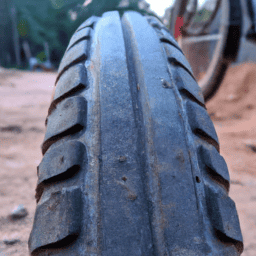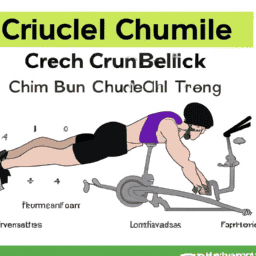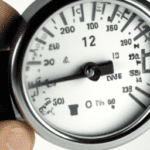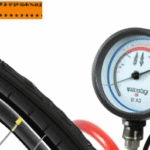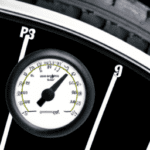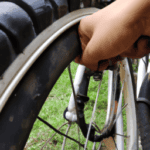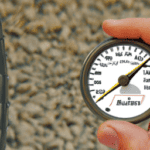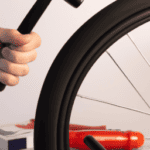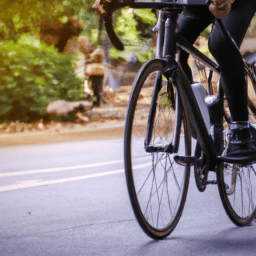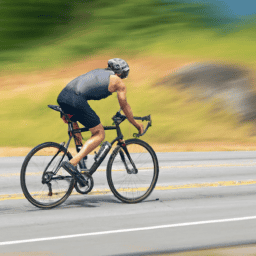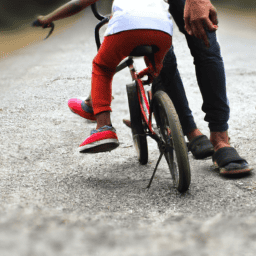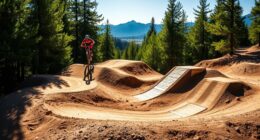Imagine this scenario: you’re cycling outdoors, taking pleasure in the breeze and physical activity, yet something doesn’t feel right. While riding, you observe that your bike tire appears deflated, despite being certain it’s fully inflated.
It’s a frustrating feeling, but don’t worry – there are several factors that can cause this phenomenon, and solutions to address each one.
In this article, we’ll explore the reasons why your bicycle tire might look flat when you’re riding, and what you can do to fix it. From understanding weight distribution on your bike to properly maintaining your tires, we’ll cover all the technical details to help you enjoy your ride with confidence.
So, if you’ve ever experienced the disconcerting feeling of a tire that appears flat while you’re riding, read on to discover the solutions to this common problem.
Key Takeaways
- Improper weight distribution on the bike can cause the front tire to appear flat.
- Saddle height should be adjusted to ensure proper weight distribution.
- Body should be centered over the bike to distribute weight evenly.
- Regularly checking and adjusting tire pressure is crucial for optimal performance.
Weight Distribution on the Bike
If you’re experiencing a flat-looking tire while riding, it could be due to improper weight distribution on the bike. One common mistake is having the saddle height too low, which can cause the rider to sit too low and put more weight on the rear wheel. This can lead to the front tire appearing flat, even though it’s properly inflated.
To fix this, make sure your saddle is at the proper height. You should be able to comfortably reach the pedals with a slight bend in your knee at the bottom of the pedal stroke.
Another factor that affects weight distribution on the bike is body position. Leaning too far forward or backward can make the front or rear tire appear flat, respectively.
To maintain proper weight distribution, keep your body centered over the bike, with your arms and legs relaxed but engaged. This will allow you to distribute your weight evenly between the front and rear wheels, keeping your tires properly inflated and your ride smooth and comfortable.
Now, let’s move on to the next section about the angle of the bike.
Angle of the Bike
As I lean into a turn, I can feel my bike stability shift, and the angle of the bike becomes an important factor. Maintaining the proper angle while turning is crucial to avoid losing control of the bike.
To achieve the correct angle, I need to position my body accordingly. By leaning my body into the turn and shifting my weight towards the inside of the curve, I can ensure that my bike remains stable and responsive to my movements.
Body positioning is not the only factor that affects the angle of the bike. The speed at which I’m riding, the type of terrain, and the radius of the turn are all important considerations.
By adjusting my body position and being aware of these factors, I can maintain control of my bike while riding and avoid the feeling of a flat tire. Speaking of which, the tire pressure of my bike is another crucial element that affects the way my bike rides.
Tire Pressure
To ensure optimal performance, make sure you regularly check and adjust the pressure in your bike’s tires, using a gauge and a pump, just like you would with your car’s tires.
Measuring pressure is crucial because if your tire pressure is too low, it can cause your bike tire to look flat when riding, making it harder to pedal and maneuver. On the other hand, if your tire pressure is too high, it can result in a harsh ride and increased risk of a blowout.
It’s recommended to check your bike’s tire pressure before each ride, or at least once a week. The recommended levels will vary depending on the type of bike and tire you have, so refer to the manufacturer’s guidelines.
It’s also important to note that temperature can affect tire pressure. As the temperature drops, so does tire pressure, and vice versa. Therefore, it’s essential to adjust the pressure accordingly, especially during colder months.
By keeping your tire pressure at the recommended levels and checking it regularly, you’ll have a smoother, safer ride.
Now, let’s move on to bike maintenance and how to keep your bike in top shape.
Bike Maintenance
Keeping your bike in top shape is crucial for a smooth and enjoyable ride. Proper maintenance is key to ensuring your bike runs smoothly and efficiently, and doesn’t leave you stranded with a flat tire. Here are three essential bike maintenance tasks to keep your ride in top shape:
-
Regular cleaning: Dirt and grime can accumulate on your bike, which can damage components and affect performance. Regularly cleaning your bike with soap and water, or a bike-specific cleaning solution, can help prevent this. Pay attention to the chain, cassette, and derailleur, which are particularly susceptible to buildup.
-
Lubrication: Applying lubricant to your bike’s chain and other moving parts can help reduce friction and extend their lifespan. Use a bike-specific lubricant and apply it sparingly, wiping off any excess to prevent buildup. Be sure to also lubricate any pivoting points, such as brake and shift levers.
-
Inspection: Regularly inspect your bike for any signs of wear and tear, such as cracks, rust, or loose bolts. Fixing any issues as soon as they arise can prevent further damage and keep your bike running smoothly.
By regularly performing these maintenance tasks, you can ensure your bike stays in top shape and ready for your next ride. Now, let’s talk about how to enjoy that ride to the fullest.
Enjoying Your Ride
Maximizing the pleasure of your cycling experience requires more than just maintaining your bike. Proper posture and pedal technique can make all the difference in how enjoyable your ride is.
When cycling, it’s important to maintain an upright posture with your back straight and shoulders relaxed. Keeping your knees in line with your toes while pedaling can also help prevent strain on your joints. It may take some practice to find the right posture and technique that works for you, but it’ll be well worth it when you can ride longer and with more comfort.
Another factor in enjoying your ride is choosing the right route. Consider the terrain and distance you plan to cover, and choose a route that will challenge you without being too difficult. Scenic routes with beautiful views can also add to the enjoyment of your ride.
In addition, be aware of traffic and choose routes with bike lanes or low traffic to ensure safety. With proper posture and technique and a well-planned route, you can maximize the pleasure of your cycling experience.
Frequently Asked Questions
How do I know if my tire is actually flat or if it just looks flat when riding?
To determine if my tire is actually flat or if it’s a visual illusion, I check for tire wear and use a pressure gauge to measure the air pressure. Visual inspection alone can be deceiving, so it’s important to use these methods for accuracy.
Can riding with a flat-looking tire cause damage to the bike or the rider?
Riding with a tire that appears flat can cause serious damage to the bike and pose safety concerns for the rider. It is crucial to regularly maintain tire pressure using appropriate tools and techniques to prevent potential issues.
Are there any techniques for maintaining tire pressure during long rides?
Maintaining proper tire pressure during long rides is crucial for optimal performance and safety. To achieve this, I recommend using a quality gauge, checking pressure before and during the ride, and keeping hydrated to prevent tire pressure fluctuations.
What are some common causes for a tire to look flat when riding, other than low pressure?
Causes of a tire looking flat when riding can include improper installation, worn-out or damaged tire, or insufficient rim tape. Solutions are to check installation, replace tire or rim tape, and ensure proper inflation.
Is it recommended to ride with a slightly lower tire pressure for better traction and comfort, or is it better to always maintain the recommended pressure?
Maintaining recommended tire pressure ensures proper handling, reduces wear, and prevents flats. However, slightly lower pressure may offer increased riding comfort and traction improvement. Consult manufacturer guidelines for optimal pressure based on rider weight and terrain.
Conclusion
In conclusion, riding a bike with a tire that looks flat can be frustrating, but it doesn’t have to ruin your ride. By understanding the factors that contribute to this issue, you can take steps to prevent it from happening in the future.
First and foremost, consider your weight distribution on the bike. If you’re putting too much weight on the front or back tire, it can cause the tire to look flat while riding. Additionally, pay attention to the angle of the bike and make sure it’s level. This can also affect the appearance of the tire.
Keep in mind that tire pressure plays a crucial role in how your bike feels on the road. Make sure to check your tire pressure regularly and adjust it as needed.
Lastly, don’t forget the importance of proper bike maintenance. Regularly inspect your tires for wear and tear and replace them as needed. As the saying goes, "a stitch in time saves nine."By taking preventative measures and addressing any issues early on, you can ensure that your bike is always ready for a smooth and enjoyable ride.
